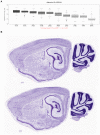Prominent and Regressive Brain Developmental Disorders Associated with Nance-Horan Syndrome
- PMID: 34573171
- PMCID: PMC8465299
- DOI: 10.3390/brainsci11091150
Prominent and Regressive Brain Developmental Disorders Associated with Nance-Horan Syndrome
Abstract
Nance-Horan syndrome (NHS) is a rare X-linked developmental disorder caused mainly by loss of function variants in the NHS gene. NHS is characterized by congenital cataracts, dental anomalies, and distinctive facial features, and a proportion of the affected individuals also present intellectual disability and congenital cardiopathies. Despite identification of at least 40 distinct hemizygous variants leading to NHS, genotype-phenotype correlations remain largely elusive. In this study, we describe a Sicilian family affected with congenital cataracts and dental anomalies and diagnosed with NHS by whole-exome sequencing (WES). The affected boy from this family presented a late regression of cognitive, motor, language, and adaptive skills, as well as broad behavioral anomalies. Furthermore, brain imaging showed corpus callosum anomalies and periventricular leukoencephalopathy. We expand the phenotypic and mutational NHS spectrum and review potential disease mechanisms underlying the central neurological anomalies and the potential neurodevelopmental features associated with NHS.
Keywords: Nance-Horan syndrome; congenital cataracts; dental anomalies; genotype; motor impairment; next-generation sequencing; pediatric age.
Conflict of interest statement
The authors declare no conflict of interest.
Figures




References
-
- Salpietro V., Malintan N.T., Llano-Rivas I., Spaeth C.G., Efthymiou S., Striano P., Vandrovcova J., Cutrupi M.C., Chimenz R., David E., et al. Mutations in the Neuronal Vesicular SNARE VAMP2 Affect Synaptic Membrane Fusion and Impair Human Neurodevelopment. Am. J. Hum. Genet. 2019;104:721–730. doi: 10.1016/j.ajhg.2019.02.016. - DOI - PMC - PubMed
LinkOut - more resources
Full Text Sources

